PT-P750W
FAQs & Troubleshooting |
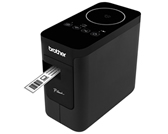
PT-P750W
Date: 25/06/2021 ID: faqp00100063_000
Using the Communication Settings (for Windows)
To use the Communication settings, please follow the steps below:
-
Open the Printer Setting Tool.
Refer to the FAQ: "Using the Printer Setting Tool (for Windows)". -
Select Communication settings.
The Communication settings window appears. - Specify or change the settings.
For information on items in the Communication settings window, refer to the following links (the screens are from Windows):
- Settings Dialog Box
- Menu Bar
- General Tab
- Wireless LAN Tab
- Wireless Direct Tab
-
Applying Setting Changes to Multiple Printers
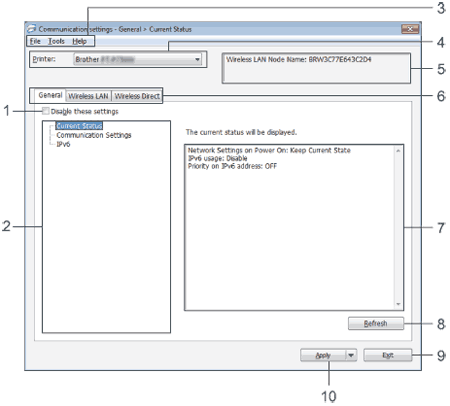
-
Disable these settings
When this check box is selected, appears in the tab, and the settings can no longer be specified or changed.
appears in the tab, and the settings can no longer be specified or changed.
The settings in a tab where appears will not be applied to the printer even if Apply is clicked. In addition, the settings in the tab will not be saved or exported when the Save in Command File or Export command is executed.
appears will not be applied to the printer even if Apply is clicked. In addition, the settings in the tab will not be saved or exported when the Save in Command File or Export command is executed.
To apply, save or export the settings to the printer, be sure to clear the check box. -
Items
When Current Status is selected, the current settings appear in the settings display/change area.
Select the item for the settings that you want to change. -
Menu Bar
Select a command contained in each menu from the list.
For details on the menu bar, see Menu Bar. -
Printer
Selects the printer whose settings are to be changed.
If only one printer is connected, it is unnecessary to make a selection since only that printer will appear. -
Node Name
Displays the node name. The node name can also be changed. (See Tools menu.) -
Settings Tabs
Click the tab containing the settings to be specified or changed.
If appears in the tab, the settings in that tab will not be applied to the printer.
appears in the tab, the settings in that tab will not be applied to the printer. -
Settings Display/Change Area
Displays the current settings for the selected item. Change the settings as necessary using the drop-down menus, direct entry or other appropriate methods. -
Refresh
Click to update the displayed settings with the most recent information. -
Exit
Exits Communication settings, and returns to the main window of the Printer Setting Tool.Settings are not applied to printers if the Exit button is clicked without clicking the Apply button after changing settings.
-
Apply
Click Apply to apply the settings to the printer.
To save the specified settings in a command file, select Save in Command File from the drop-down menu.Clicking Apply applies all settings in all tabs to the printer. If the Disable these settings check box is selected, the settings in that tab are not applied.
-
Apply Settings to the Printer
Applies the settings to the printer.If the Disable these settings check box is selected, the settings in that tab are not saved.
-
Save Settings in Command File
Saves the specified settings in a command file.
The file extension is “.bin”.- If the Disable these settings check box is selected, the settings in that tab are not saved.
-
The following information is not saved with the settings commands.
- Node name
- IP address, subnet mask and default gateway (when the IP address is set to STATIC)
- The saved communication settings commands are only intended to be used for applying settings to a printer. The settings cannot be applied by importing this command file.
-
Saved command files contain authentication keys and passwords.
Take necessary measures to protect saved command files, such as by saving them in a location that cannot be accessed by other users. - Do not send the command file to a printer whose model was not specified when the command file was exported.
-
Import
-
Import from the current computer wireless settings
Imports the settings from the computer.- Only personal security authentication settings (open system, public key authentication and WPA/WPA2-PSK) can be imported. Enterprise security authentication (such as LEAP and EAP-FAST) and WPA2-PSK (TKIP+AES) settings cannot be imported.
- If multiple wireless LANs are enabled for the computer being used, the first wireless settings (only personal settings) that are detected will be considered for the import data.
- Only settings (communication mode, SSID, authentication method, encryption mode and authentication key) from the Wireless LAN tab - Wireless Settings pane can be imported.
-
Select a Profile to import
Imports the exported file and applies the settings to a printer.
Click Browse to display a dialog box for browsing for the file. Select the file to be imported. The settings in the selected file appear in the settings display/change area.- All settings, such as wireless settings or TCP/IP settings, can be imported. However, node names cannot be imported.
- Only profiles that are compatible with the selected printer can be imported.
- If the imported profile’s IP address is set to STATIC, change the IP address of the imported profile, if necessary, so that it does not duplicate the IP address of an existing printer on the network whose settings have been completed.
-
Import from the current computer wireless settings
-
Export
Saves the current settings in a file.- If the Disable these settings check box is selected, the settings in that tab are not saved.
- Exported files are not encrypted.
-
Option Settings
-
Automatically restart the printer after applying new settings
If this check box is selected, the printer automatically restarts after communication settings are applied.
If this check box is cleared, printers must be manually restarted.When configuring multiple printers, you can reduce the time required to change settings by clearing this check box. In this case, we recommend selecting this check box when configuring the first printer so that you can confirm that each setting is operating as intended.
-
Automatically detects the connected printer, and retrieves the current settings.
If this check box is selected and a printer is connected to the computer, the printer is automatically detected and the printer’s current settings are displayed in the Current Status page.If the model of the connected printer is different than that of the printer shown in the Printer drop-down list, the settings available on all tabs will change to match the connected printer.
-
Automatically restart the printer after applying new settings
-
Change Node Name
Allows each node name to be changed. -
Reset to Default Communication Settings
Returns the communication settings to their factory defaults.
Help menu
-
Display Help
Displays the Help. -
About
Displays the version information.
Communication settings
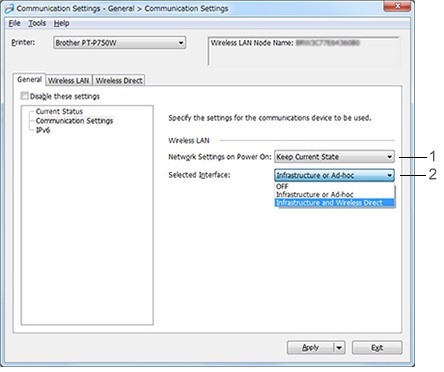
-
Network Settings on Power On
Determines the conditions for connecting via Wi-Fi® when the printer is turned on. Select Wireless LAN by Default, Off by default or Keep Current State. -
Selected Interface
Select OFF, Infrastructure or Ad-hoc or Infrastructure and Wireless Direct.
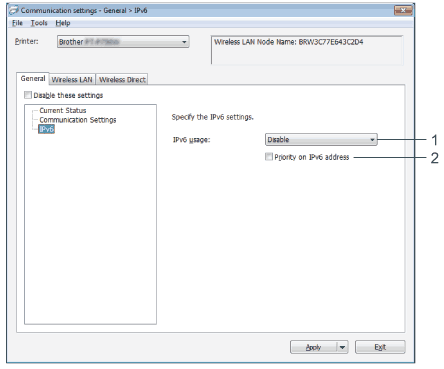
-
IPv6 Usage
Select Enable or Disable. -
Priority on IPv6 address
Select to give priority to an IPv6 addresses.
TCP/IP (Wireless)
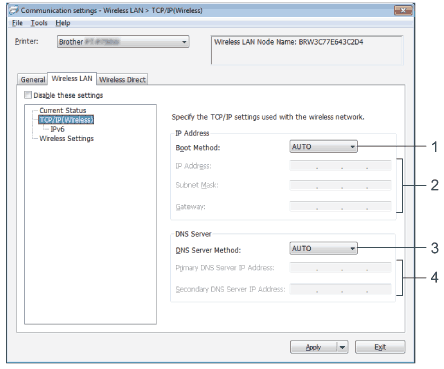
-
Boot Method
Select STATIC, AUTO, BOOTP, DHCP or RARP. -
IP Address/Subnet Mask/Gateway
Specify the various values.
You can only enter settings when the IP address is set to STATIC. -
DNS Server Method
Select STATIC or AUTO. -
Primary DNS Server IP Address/Secondary DNS Server IP Address
You can only enter settings when the DNS server is set to STATIC.
IPv6
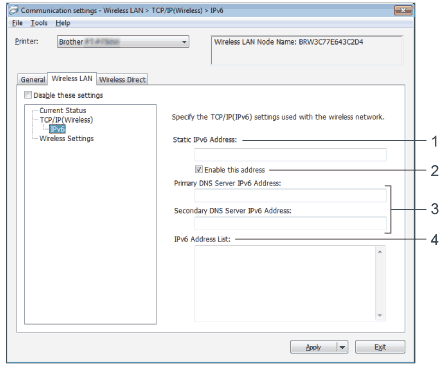
-
Static IPv6 Address
Specify the value. -
Enable this address
Select to make the specified static IPv6 address effective. -
Primary DNS Server IPv6 Address/Secondary DNS Server IPv6 Address
Specify the values. -
IPv6 Address List
Displays the list of IPv6 addresses.
Wireless Settings
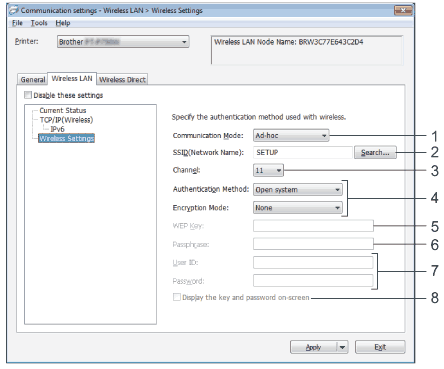
-
Communication Mode
Select Ad-hoc or Infrastructure. -
SSID (Network Name)
Click the Search button to display the SSID selections in a separate dialog box. -
Channel
Select from the displayed options. -
Authentication Method/Encryption Mode
The supported encryption modes for the various authentication methods are as shown in Communication Modes and Authentication Methods/Encryption Modes. -
WEP Key
You can only specify a setting when WEP is selected as the encryption mode. -
Passphrase
You can only specify a setting when WPA2-PSK, or WPA/WPA2-PSK is selected as the authentication method. -
User ID/Password
You can only specify settings when LEAP, EAP-FAST, EAP-TTLS or EAP-TLS is selected as the authentication method. In addition, with EAP-TLS, it is not necessary to register a password, but a client certificate must be registered. To register a certificate, connect to the printer from a web browser, and then specify the certificate. -
Display the key and password on-screen
If this check box is selected, keys and passwords will be displayed in plain text (non-encrypted text).
Communication Modes and Authentication Methods/Encryption Modes
-
When Communication Mode is set to Ad-hoc
Authentication Method
Encryption Mode
Open System
None / WEP
-
When Communication Mode is set to Infrastructure
Authentication Method
Encryption Mode
Open System
None / WEP
Shared Key
WEP
WPA2-PSK
AES
WPA/WPA2-PSK
TKIP+AES / AES
LEAP
CKIP
EAP-FAST/NONE
TKIP+AES / AES
EAP-FAST/MS-CHAPv2
TKIP+AES / AES
EAP-FAST/GTC
TKIP+AES / AES
PEAP/MS-CHAPv2
TKIP+AES / AES
PEAP/GTC
TKIP+AES / AES
EAP-TTLS/CHAP
TKIP+AES / AES
EAP-TTLS/MS-CHAP
TKIP+AES / AES
EAP-TTLS/MS-CHAPv2
TKIP+AES / AES
EAP-TTLS/PAP
TKIP+AES / AES
EAP-TLS
TKIP+AES / AES
To perform higher level security settings:
When performing certificate verification with EAP-FAST, PEAP, EAP-TTLS or EAP-TLS authentication methods, the certificate cannot be specified from the Printer Setting Tool. After the printer is configured to connect to the network, specify the certificate by accessing the printer from a web browser.
Wireless Direct Settings
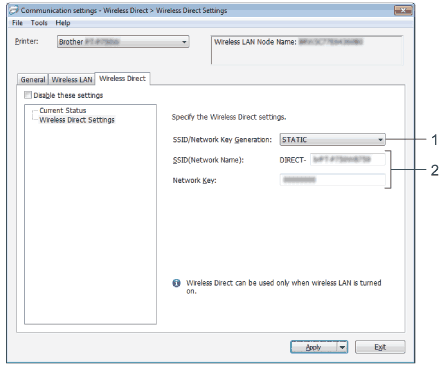
-
SSID/Network Key Generation
Select AUTO or STATIC. -
SSID (Network Name)/Network Key
Enter the SSID (25 ASCII characters or less) and the network key (63 characters or less) to be used in the Wireless Direct mode.
You can only specify a setting when STATIC is selected as SSID/Network Key Generation.
Applying Setting Changes to Multiple Printers
- After applying settings to the first printer, disconnect the printer from the computer, and then connect the second printer to the computer.
-
Select the newly connected printer from the Printer drop-down box.
If the Automatically detects the connected printer, and retrieves the current settings. check box in the Option Settings dialog box is selected, the printer connected with the USB cable is automatically selected.
For details, see File menu. -
Click the Apply button.
The same settings that were applied to the first printer are applied to the second printer.If the Automatically restart the printer after applying new settings check box is cleared, the printers will not be restarted after the settings are changed, reducing the time required to configure the printers. However, we recommend selecting the Automatically restart the printer after applying new settings check box when configuring the first printer so that you can confirm that a connection with the access point can be correctly established with the settings. For details, see File menu.
-
Repeat steps 1 - 3 for all the printers whose settings you wish to change.
-
If the IP address is set to STATIC, the printer’s IP address will also be changed to the same address as the first printer.
Change the IP address if necessary. -
To save the current settings in a file, click File - Export.
The same settings can be applied to another printer by clicking File - Import, then selecting the exported settings file. (See File menu.)
-
If the IP address is set to STATIC, the printer’s IP address will also be changed to the same address as the first printer.
Not all computers, mobile devices, and operating systems, may support Ad-hoc mode.
PT-P750W
If you need further assistance, please contact Brother customer service:
Content Feedback
Please note this form is used for feedback only.